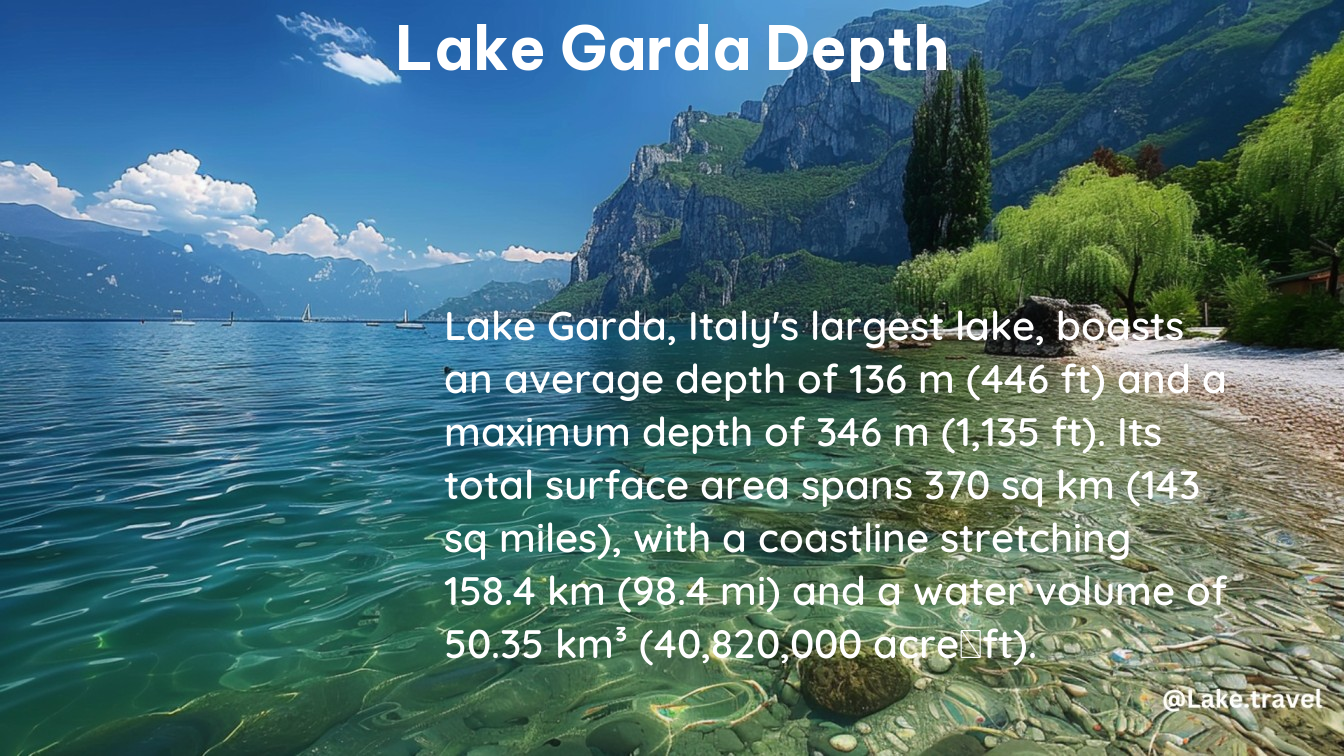Lake Garda, the largest lake in Italy, boasts a maximum depth of 346 meters (1,135 feet) and an average depth of 136 meters (446 feet). This impressive depth is a result of the lake’s unique location, nestled within the Alps and the upper Pianura Padana region.
The Depth of Lake Garda
As the largest lake in Italy, Lake Garda’s depth is a testament to its geological history. The lake’s shape is typical of a moraine valley, likely formed under the action of a Paleolithic glacier. This glacial origin has contributed to the lake’s impressive depth, with the northern part situated within the Alps and the southern portion occupying an area of the upper Pianura Padana.
| Depth Measurement | Value |
|---|---|
| Maximum Depth | 346 meters (1,135 feet) |
| Average Depth | 136 meters (446 feet) |
The limited size of the hydrographic basin (2,290 square kilometres or 880 square miles) compared to the lake’s surface area is a unique feature of Lake Garda. This ratio of basin size to lake surface area is a key factor in understanding the lake’s depth and overall characteristics.
Rare and Endemic Species

Lake Garda is home to a rare salmonid fish, the carpione (Salmo carpio), which is endemic to the lake. This means that the carpione is found naturally only in Lake Garda and nowhere else in the world. Attempts to introduce the carpione to other lakes in Italy and elsewhere have been unsuccessful, highlighting the unique and delicate ecosystem of Lake Garda.
Unfortunately, the population of carpione in Lake Garda has been declining due to various factors, including the introduction of non-native fish species and pollution. Conservation efforts are underway to protect this rare and valuable species, which is an integral part of the lake’s biodiversity.
Recreational Activities and Tourism
The depth of Lake Garda, combined with its Mediterranean microclimate and mild temperatures, make it a popular destination for a variety of outdoor activities. Sailing, windsurfing, mountain biking, and trekking are just a few of the activities that draw visitors to the lake’s shores.
The northern side of the lake, from Malcesine to Limone up to Riva del Garda, is particularly renowned for its winds, making it a hub for windsurfing and sailing enthusiasts. The lake’s waters are typically around 20° Celsius during the summer, making swimming a pleasant and refreshing experience.
Unique Geological Features
The depth of Lake Garda is not only impressive but also a reflection of the lake’s unique geological history. The lake’s location in a depression that insinuates itself into the Alps has contributed to its distinctive shape and depth.
The moraine valley formation, likely created by the action of a Paleolithic glacier, has resulted in the lake’s characteristic elongated shape and impressive depth. This glacial origin has also influenced the lake’s hydrology and the distribution of its flora and fauna.
Conclusion
Lake Garda’s depth is a captivating feature that has shaped the lake’s unique ecosystem and recreational opportunities. With a maximum depth of 346 meters (1,135 feet) and an average depth of 136 meters (446 feet), the lake’s impressive depth is a testament to its geological history and the forces that have sculpted this remarkable natural wonder.
As a hub for outdoor enthusiasts and a home to rare and endemic species, Lake Garda continues to captivate visitors and researchers alike. By understanding the depth and its significance, we can better appreciate the complexity and beauty of this remarkable Italian lake.
References:
– Wikipedia – Lake Garda
– Blog Toblini – 5 Things You Don’t Know About Lake Garda
– Wikipedia – Lake Garda Morphology and Hydrography
